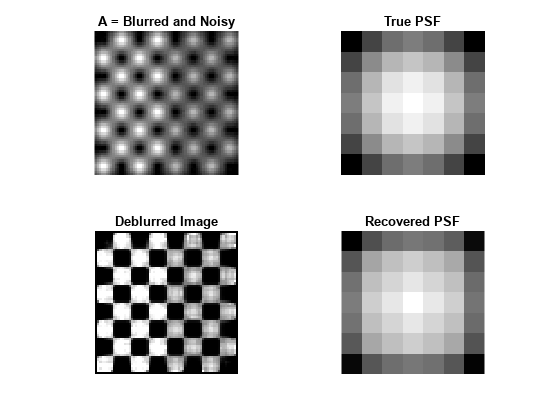deconvblind
Deblur image using blind deconvolution
Syntax
Description
[
deconvolves image J,psfr] = deconvblind(I,psfi)I using the maximum likelihood algorithm and
an initial estimate of the point-spread function (PSF), psfi.
The deconvblind function returns both the deblurred image
J and a restored PSF, psfr.
To improve the restoration, deconvblind supports several
optional parameters, described below. Use [] as a placeholder if
you do not specify an intermediate parameter.
[
specifies which pixels in the input image J,psfr] = deconvblind(I,psfi,iter,dampar,weight)I are considered in the
restoration. The value of an element in the weight array
determines how much the pixel at the corresponding position in the input image is
considered. For example, to exclude a pixel from consideration, assign it a value of
0 in the weight array. You can adjust
the weight value assigned to each pixel according to the amount of flat-field
correction.
[,
where J,psfr] = deconvblind(___,fun)fun is a handle to a function that describes additional
constraints on the PSF. fun is called at the end of each
iteration. For more information about function handles, see Create Function Handle.
Examples
Input Arguments
Output Arguments
Tips
You can use
deconvblindto perform a deconvolution that starts where a previous deconvolution stopped. To use this feature, pass the input imageIand the initial guess at the PSF,psfi, as cell arrays:{I}and{psfi}. When you do, thedeconvblindfunction returns the output imageJand the restored point-spread function,psfr, as cell arrays, which can then be passed as the input arrays into the nextdeconvblindcall. The output cell arrayJcontains four elements:J{1}containsI, the original image.J{2}contains the result of the last iteration.J{3}contains the result of the next-to-last iteration.J{4}is an array generated by the iterative algorithm.The output image
Jcould exhibit ringing introduced by the discrete Fourier transform used in the algorithm. To reduce the ringing, useI = edgetaper(I,psfi)before callingdeconvblind.
References
[1] D.S.C. Biggs and M. Andrews, Acceleration of iterative image restoration algorithms, Applied Optics, Vol. 36, No. 8, 1997.
[2] R.J. Hanisch, R.L. White, and R.L. Gilliland, Deconvolutions of Hubble Space Telescope Images and Spectra, Deconvolution of Images and Spectra, Ed. P.A. Jansson, 2nd ed., Academic Press, CA, 1997.
[3] Timothy J. Holmes, et al, Light Microscopic Images Reconstructed by Maximum Likelihood Deconvolution, Handbook of Biological Confocal Microscopy, Ed. James B. Pawley, Plenum Press, New York, 1995.
Version History
Introduced before R2006a

